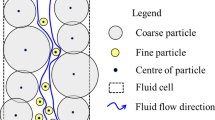A cut-off wall is the simplest and most effective preventive measure to mitigate the internal erosion of a dike foundation. However, flow directions around a cut-off wall vary and dike foundations are composed of various soil particles. Thus, to investigate the effects of flow direction and soil composition on internal erosion in a cut-off wall structure, we used a coupled distinct element method with the Darcy fluid model. We discovered that the hydraulic gradient is the main factor affecting internal erosion with larger hydraulic gradients producing faster increases in eroded mass. Moreover, the erosion mechanism along the cut-off wall was related to the flow direction and the fine particle content. Downstream of the cut-off wall, the upward flow made the soil matrix loosen gradually, which assisted soil particle erosion. Upstream of the cut-off wall, soil with higher fine particle content was compressed gradually under the action of the downward flow; however, the downward flow assisted the migration of soil particles with lower fine particle content.
Similar content being viewed by others
References
P. Talukdar and A. Dey, “Hydraulic failures of earthen dams and embankments,” Innov. Infrastr. Solut. 4, 42 (2019).
W. Wu, M. Altinakar, and M. Al-Riffai, et. al, “Earthen embankment breaching,” J. Hydraul. Eng., 137(12), 1549-1564 (2011).
L. M. Zhang and Q. Chen, “Seepage failure mechanism of the Gouhou rockfill dam during reservoir water infiltration,” Soils and Foundations, 46, 557-568 (2006).
L. M. Zhang, Y. Xu, J. S. Jia, and C. Zhao, “Diagnosis of embankment dam distresses using Bayesian networks. Part I. Global-level characteristics based on a dam distress database,” Can. Geotech. J., 48, 1630-1644 (2011).
V. S. Istomina, Filtration Stability of Soils [in Russian], Gostroizdat, Moscow, Leningrad (1957).
C. F. Wan and R. Fell, “Assessing the potential of internal instability and suffusion in embankment dams and their foundations,” J. Geotech. Geoenviron. Eng., 134, 401-407 (2008).
B. Indraratna, V. T. Nguyen, and C. Rujikiatkamjorn, “Assessing the potential of internal erosion and suffusion of granular soils,” J. Geotech. Geoenviron. Eng., 137, 550-554 (2011).
K. Lin and T. Akihiro, “Experimental investigations on suffusion characteristics and its mechanical consequences on saturated cohesionless soil,” Soils and Foundations, 54, 713-730 (2014).
H. Kazuki and T. Akihiro, “Suffusion-induced change in spatial distribution of fine fractions in embankment subjected to seepage flow,” Soils and Foundations, 55, 1293-1304 (2015).
V. N. Zhilenkov, “Recommendations for a laboratory testing procedure to determine permeability and suffosion stability of soils,” Izd. VNIIG im. B. E. Vedeneeva, Leningrad (1991).
M. Andreini, P. Gardoni, S. Pagliara, and M. Sassu, “Probabilistic models for the erosion rate in embankments and reliability analysis of earth dams,” Reliab. Eng. Syst. Saf., 181, 142-155 (2019).
K. Weaver and D. A. Bruce, Dam Foundation Grouting, ASCE Press, New York (2007).
D. A. Bruce and S. Stefani, “Rehabilitation of Beaver Dam: a major seepage cut-off wall,” Ground Engineering, 29, 40-45 (1996).
C. E. Maxwell, D. B. Neil, R. M. Jack, and P. Nick, “Meibourne’s South bank interchange: A permanent excavation in compressible clay,” Canadian Geotechnical Journal, 41, 861-876 (2004).
D. A. Bruce, A. R. Di Cervia, and J. Amos-Venti, “Seepage remediation by positive cut-off walls: a compendium and analysis of North American case histories,” Canadian Dam Association Conference, Québec City, Québec, Canada (2006).
A. Uromeihy and G. Barzegari, “Evaluation and treatment of seepage problems at Chapar-Abad Dam, Iran,” Engineering Geology, 91, 219-228 (2007).
A. Uromeihy and R. Farrokhi, “Evaluating groutability at the Kamal-Saleh Dam based on Lugeon tests,” Bulletin of Engineering Geology and Environment, 71, 215-219 (2012).
D. Y. Wang, X. D. Fu, Y. X. Jie, W. J. Dong, and D. Hu, “Simulation of pipe progression in a levee foundation with coupled seepage and pipe flow domains,” Soils and Foundations, 54, 974-984 (2014).
N. Benmebarek, S. Benmebarek, and R. Kastner, “Numerical studies of seepage failure of sand within a cofferdam,” Computers and Geotechnics, 32, 264–273 (2005).
R. B. Wudtke, “Failure mechanisms of hydraulic heave at excavation,” 19th European Young Geotechnical Engineers’ Conference, Gyor, Hungary (2008).
Y. L. Luo, M. L. Zhan, J. C. Sheng, and Q. Wu, “Hydro-mechanical coupling mechanism on joint of clay core-wall and concrete cut-off wall,” J. Cent. South Univ., 20, 2578-2585 (2013).
S. Wang, J. S. Chen, J. C. Sheng, and Y. L. Luo, “Laboratory investigation of stress state and grain composition affecting internal erosion in soils containing a suspended cut-off wall,” KSCE Journal of Civil Engineering, 20, 1283-1293 (2016).
Author information
Authors and Affiliations
Corresponding author
Additional information
Translated from Osnovaniya, Fundamenty i Mekhanika Gruntov, No. 6, November-December, 2023.
Rights and permissions
Springer Nature or its licensor (e.g. a society or other partner) holds exclusive rights to this article under a publishing agreement with the author(s) or other rightsholder(s); author self-archiving of the accepted manuscript version of this article is solely governed by the terms of such publishing agreement and applicable law.
About this article
Cite this article
Wang, S., Tang, Y., Zhong, Q. et al. Numerical Modeling on Fluid-Solid Coupled Erosion in Sandy Gravel Soils Containing a Suspended Cut-Off Wall. Soil Mech Found Eng 60, 595–602 (2024). https://doi.org/10.1007/s11204-024-09934-2
Published:
Issue Date:
DOI: https://doi.org/10.1007/s11204-024-09934-2




